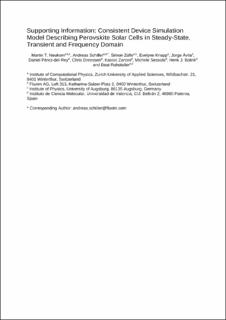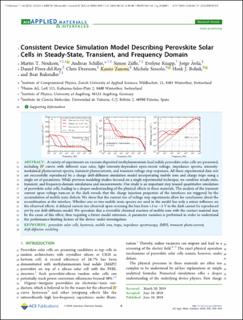Please use this identifier to cite or link to this item:
https://doi.org/10.21256/zhaw-18965| Publication type: | Article in scientific journal |
| Type of review: | Peer review (publication) |
| Title: | Consistent device simulation model describing perovskite solar cells in steady-state, transient, and frequency domain |
| Authors: | Neukom, Martin T. Schiller, Andreas Züfle, Simon Knapp, Evelyne Ávila, Jorge Pérez-del-Rey, Daniel Dreessen, Chris Zanoni, Kassio P.S. Sessolo, Michele Bolink, Henk J. Ruhstaller, Beat |
| et. al: | No |
| DOI: | 10.1021/acsami.9b04991 10.21256/zhaw-18965 |
| Published in: | ACS Applied Materials & Interfaces |
| Volume(Issue): | 11 |
| Issue: | 26 |
| Page(s): | 23320 |
| Pages to: | 23328 |
| Issue Date: | 10-Jun-2019 |
| Publisher / Ed. Institution: | American Chemical Society |
| ISSN: | 1944-8244 1944-8252 |
| Language: | English |
| Subjects: | IMPS; Drift-diffusion modeling; Hysteresis; Impedance spectroscopy; Mobile ions; Perovskite solar cells; Transient photo-current; Traps |
| Subject (DDC): | 621.3: Electrical, communications, control engineering |
| Abstract: | A variety of experiments on vacuum-deposited methylammonium lead iodide perovskite solar cells are presented, including JV curves with different scan rates, light intensity-dependent open-circuit voltage, impedance spectra, intensity-modulated photocurrent spectra, transient photocurrents, and transient voltage step responses. All these experimental data sets are successfully reproduced by a charge drift-diffusion simulation model incorporating mobile ions and charge traps using a single set of parameters. While previous modeling studies focused on a single experimental technique, we combine steady-state, transient, and frequency-domain simulations and measurements. Our study is an important step toward quantitative simulation of perovskite solar cells, leading to a deeper understanding of the physical effects in these materials. The analysis of the transient current upon voltage turn-on in the dark reveals that the charge injection properties of the interfaces are triggered by the accumulation of mobile ionic defects. We show that the current rise of voltage step experiments allow for conclusions about the recombination at the interface. Whether one or two mobile ionic species are used in the model has only a minor influence on the observed effects. A delayed current rise observed upon reversing the bias from +3 to -3 V in the dark cannot be reproduced yet by our drift-diffusion model. We speculate that a reversible chemical reaction of mobile ions with the contact material may be the cause of this effect, thus requiring a future model extension. A parameter variation is performed in order to understand the performance-limiting factors of the device under investigation. |
| Further description: | This document is the Accepted Manuscript version of a Published Work that appeared in final form in ACS Applied Materials & Interfaces, copyright © American Chemical Society after peer review and technical editing by the publisher. To access the final edited and published work see https://pubs.acs.org/doi/10.1021/acsami.9b04991 |
| URI: | https://digitalcollection.zhaw.ch/handle/11475/18965 |
| Fulltext version: | Accepted version |
| License (according to publishing contract): | Licence according to publishing contract |
| Restricted until: | 2020-06-11 |
| Departement: | School of Engineering |
| Organisational Unit: | Institute of Computational Physics (ICP) |
| Published as part of the ZHAW project: | PV2050: Simulation and Characterization |
| Appears in collections: | Publikationen School of Engineering |
Files in This Item:
| File | Description | Size | Format | |
|---|---|---|---|---|
| Neukom_ACSApplMaterInt xx,xxx 2019_Supp.pdf | Supporting Information | 1.96 MB | Adobe PDF |  View/Open |
| PSC_Sim_proof.pdf | Revised Manuscript | 980.08 kB | Adobe PDF |  View/Open |
Show full item record
Neukom, M. T., Schiller, A., Züfle, S., Knapp, E., Ávila, J., Pérez-del-Rey, D., Dreessen, C., Zanoni, K. P. S., Sessolo, M., Bolink, H. J., & Ruhstaller, B. (2019). Consistent device simulation model describing perovskite solar cells in steady-state, transient, and frequency domain. ACS Applied Materials & Interfaces, 11(26), 23320–23328. https://doi.org/10.1021/acsami.9b04991
Neukom, M.T. et al. (2019) ‘Consistent device simulation model describing perovskite solar cells in steady-state, transient, and frequency domain’, ACS Applied Materials & Interfaces, 11(26), pp. 23320–23328. Available at: https://doi.org/10.1021/acsami.9b04991.
M. T. Neukom et al., “Consistent device simulation model describing perovskite solar cells in steady-state, transient, and frequency domain,” ACS Applied Materials & Interfaces, vol. 11, no. 26, pp. 23320–23328, Jun. 2019, doi: 10.1021/acsami.9b04991.
NEUKOM, Martin T., Andreas SCHILLER, Simon ZÜFLE, Evelyne KNAPP, Jorge ÁVILA, Daniel PÉREZ-DEL-REY, Chris DREESSEN, Kassio P.S. ZANONI, Michele SESSOLO, Henk J. BOLINK und Beat RUHSTALLER, 2019. Consistent device simulation model describing perovskite solar cells in steady-state, transient, and frequency domain. ACS Applied Materials & Interfaces. 10 Juni 2019. Bd. 11, Nr. 26, S. 23320–23328. DOI 10.1021/acsami.9b04991
Neukom, Martin T., Andreas Schiller, Simon Züfle, Evelyne Knapp, Jorge Ávila, Daniel Pérez-del-Rey, Chris Dreessen, et al. 2019. “Consistent Device Simulation Model Describing Perovskite Solar Cells in Steady-State, Transient, and Frequency Domain.” ACS Applied Materials & Interfaces 11 (26): 23320–28. https://doi.org/10.1021/acsami.9b04991.
Neukom, Martin T., et al. “Consistent Device Simulation Model Describing Perovskite Solar Cells in Steady-State, Transient, and Frequency Domain.” ACS Applied Materials & Interfaces, vol. 11, no. 26, June 2019, pp. 23320–28, https://doi.org/10.1021/acsami.9b04991.
Items in DSpace are protected by copyright, with all rights reserved, unless otherwise indicated.